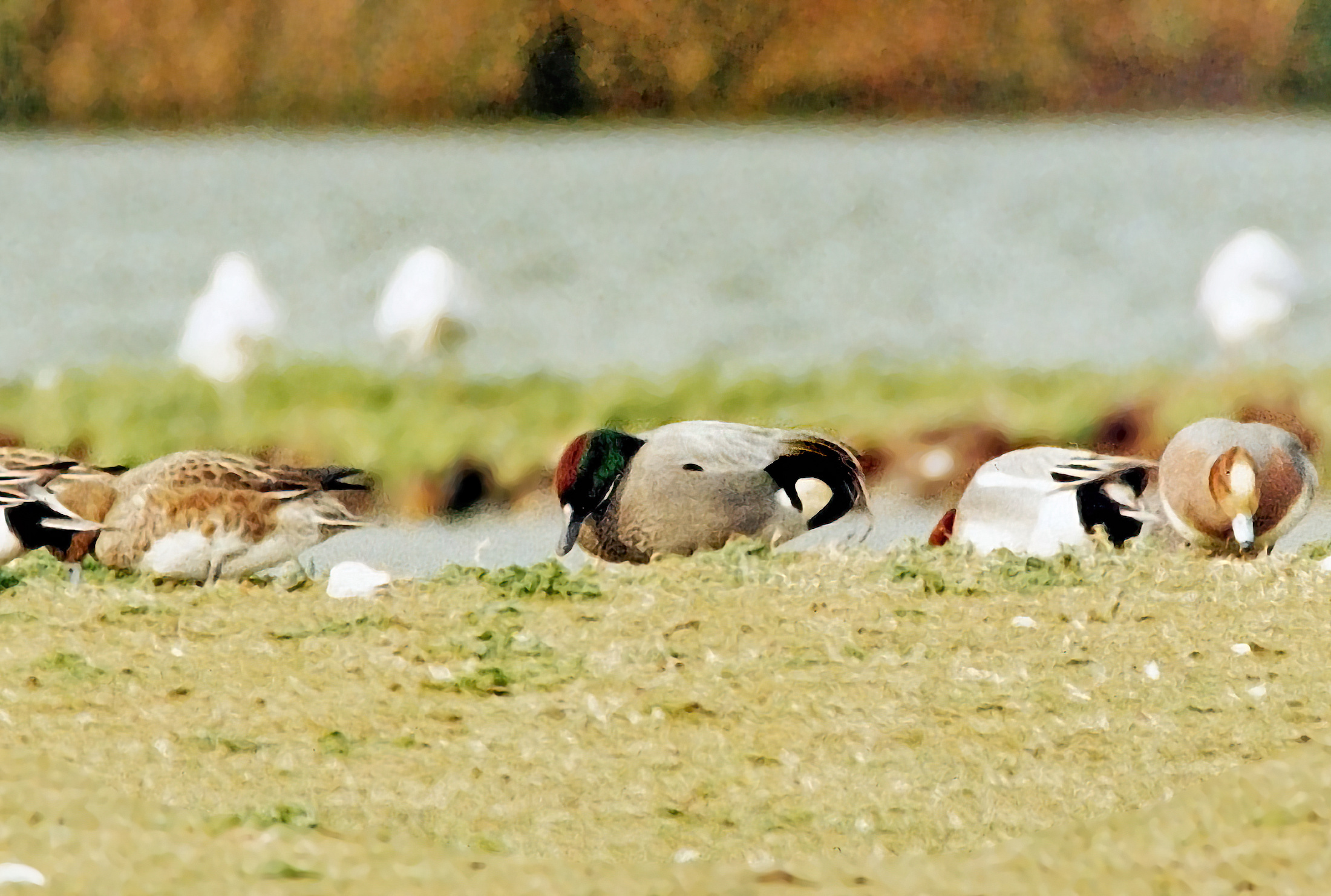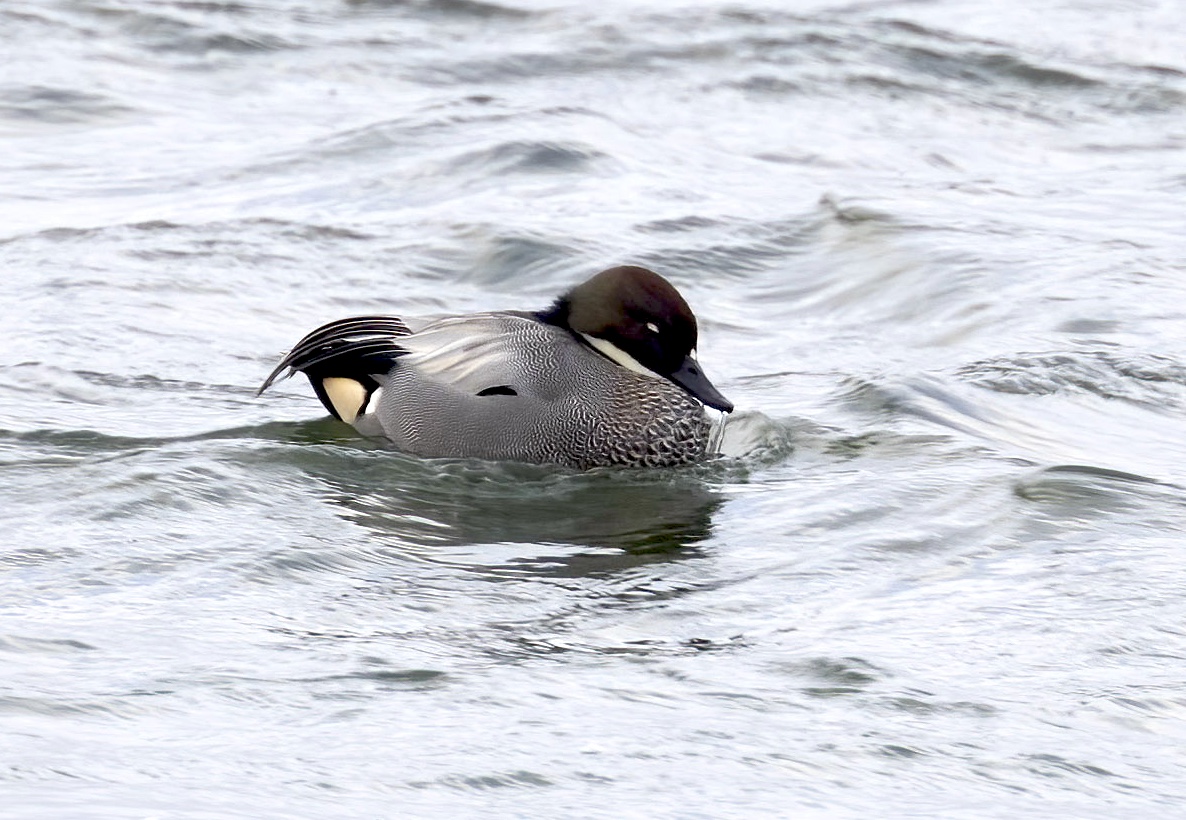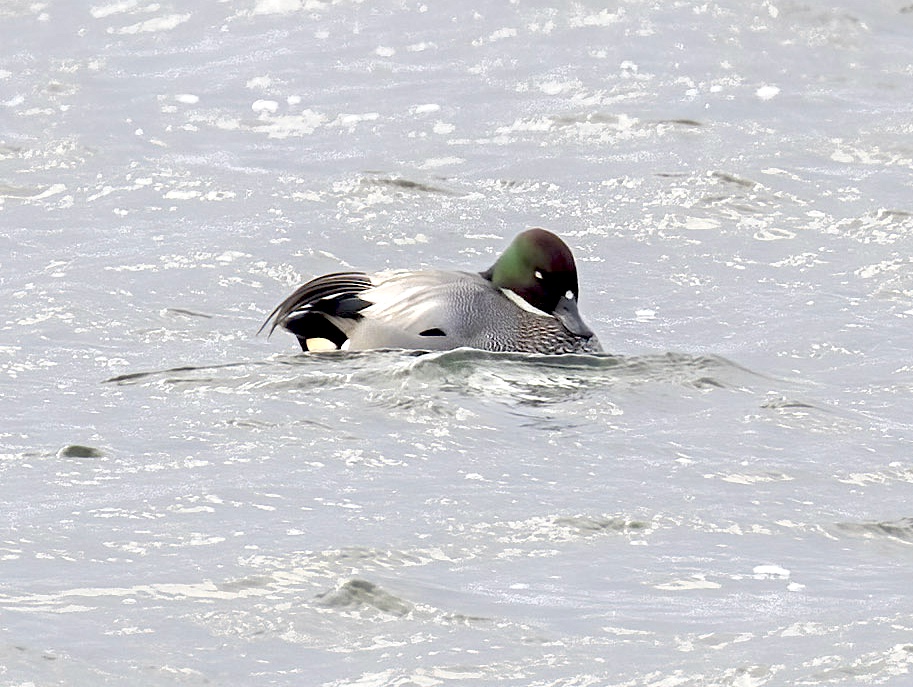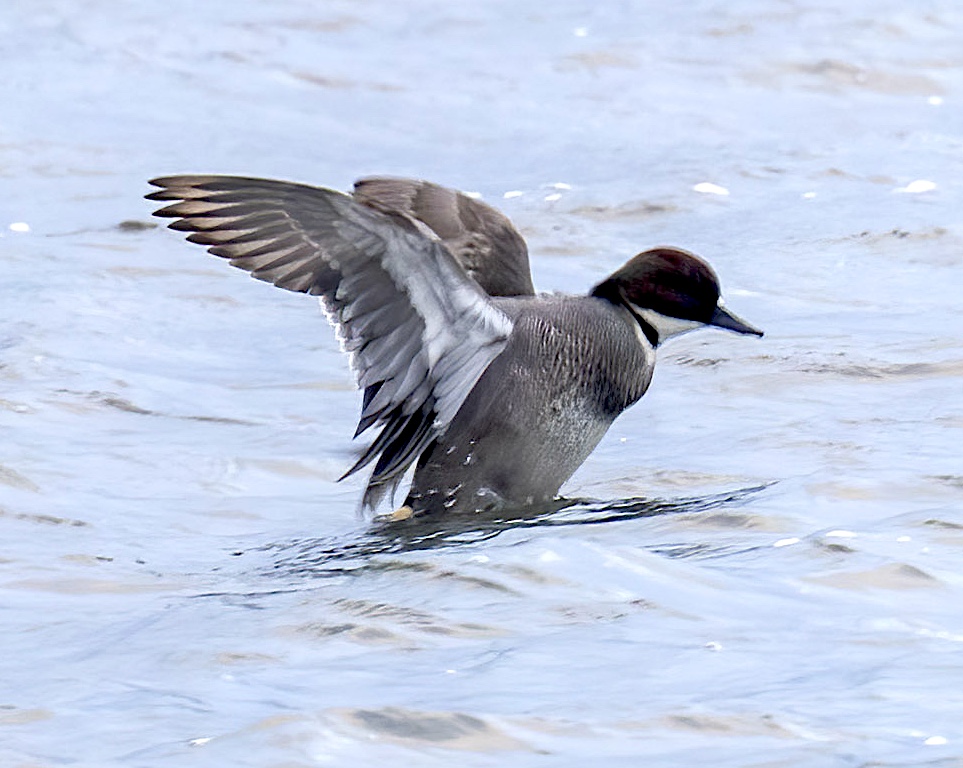Falcated Duck Mareca falcata
Vagrant. East Asia. Two accepted records; BOU category A/E.




Falcated Ducks: with Eurasian Wigeon Kirkby GP February 21st 1995(Alan Tate); Covenham Reservoir, January 2023 (G. P. Catley)
Field identification is often straightforward but determining their provenance as either wild or of captive origin can be extremely problematic and this species is no exception. The assessment of this species’ position on the British List has lasted for more than 30 years but after an extensive review of British records of Falcated Duck by the BOURC, the species was added to Category A of the British List in February 2019. The index record was determined to have been a drake present at Welney (Norfolk) December 9th-27th 1986; it moved to Pitsford Reservoir, Northamptonshire, from February 15th-April 5th 1987 and returned the following autumn and winter to Welney on August 20th-October 8th, then moving to Northamptonshire from December 12th. The drake present at Kirkby GP February 19th-21st 1995 was one of several records reviewed retrospectively and accepted by BBRC (British Birds 2020), the first county record.
With regard to the 2023 record, the BBRC commented as follows:
There was much debate among the Committee over the provenance of the 2023 bird, and whether its association with Mallards Anas platyrhynchos fulfilled the ‘appropriate carrier species’ requirement for acceptance of rare wildfowl. This was initially viewed negatively – but the same flock also contained Northern Shovelers Spatula clypeata, Common Goldeneyes Bucephala clangula, Goosanders Mergus merganser and, perhaps most importantly, Eurasian Wigeons Mareca penelope, all of which could have been of Continental – and certainly wild – origin. While Wigeon is often viewed as the ‘ideal’ carrier species, Mallard may not be as poor a companion as first assumed; there are ringing recoveries of Mallards originating from as far east as the Urals and, while this is not as far as the ringing recoveries from some Wigeons (some of which have originated around the Lake Baikal area), it is perhaps far enough to pick up any west-bound Falcated Ducks. A small private wildfowl collection close to Covenham Reservoir did not, contrary to opinion at the time, hold any Falcated Ducks, and the bird’s departure overnight on 26th/27th January coincided with Wigeons and Eurasian Teals Anas crecca also leaving the site.
Falcated Duck breeds mainly in eastern Russia, in southern Siberia, Transbaikal, Amurland and Ussuriland. Outside Russia it also nests in Japan, parts of Mongolia and northeast China but it is nowhere common. The most recent estimate puts the global population at 89,000 birds with around 78,000 of these in China outside the breeding season. The species has also been recorded as a vagrant in the Indian Subcontinent, Central Asia, the Middle East, Europe and North America (Carboneras and Kirwan 2020).
| Site | First date | Last date | Count | Notes |
| Kirkby GP | 19/02/1995 | 21/02/1995 | 1 | Adult male |
| Covenham Reservoir | 26/01/2023 | - | 1 | Adult male |
Finder’s report: Falcated Duck at Kirkby GP, February 19th, 1995, first county record.
by D. Jenkins.
Note: this account is taken from the original BBRC submission.
Circumstances
On the afternoon of February 19th, 1995, I was driving around the Kirkby-on-Bain area mainly looking for ‘white-winged’ gulls around the pits, where most of them can be viewed from the car. On pulling up at the last pit at TF231602 I quickly scanned the grazing Wigeon and immediately picked up the drake Falcated Duck on a grassy island. Initially I was somewhat unmoved by this (thinking in terms of escapes) and was surprised to see it get up and fly with the 20 or so Wigeon as soon as I got out of the car. When it eventually settled back down it appeared very nervous and alert. It was also unringed and had no obvious feather damage. I do realise however that none of these factors prove its origin either way.
The bird spent its time grazing with Wigeon on an island with short grass. When alarmed it quickly flew up, either to fly around, or to alight on the water. It appeared at times to be displaying to Wigeon giving a head-throwing display.
Description
A Gadwall-sized duck looking surprisingly heavy-bodies (particularly out of the water). Its long nape feathers gave it a maned/large-headed appearance. Also, fancy, elongated tertials curved down over its rear end.
Generally dark-headed with a dark purple crown, with the rest of the head and face dark green. This contrasted with a white throat. Body colour was various shades of grey, with its flanks being the darker and somewhat vermiculated in pattern. A whitish rear flank spot was partly obscured by the elongated tertials curving down over its rear. Spectrum not noted.
Follow up
The next day, February 20th, I made several local enquiries with wildfowl collections in the area as by now the bird was on the national birdlines.” Tales of the riverbank” at Tattershall Bridge informed me that they had never owned a Falcated Duck and put me in touch with a dealer at Mareham. He also said that he had never owned one and didn’t even know of any in the area, pointing out the relative high cost of the species, which made them rare in captivity.
I do realise the sensitive nature of records like this and no doubt it will go into the “unknown origin” file, but it is interesting to note that the record does fit a pattern for this species in its February occurrences, both here in Britain and on the continent, notably these:
Potteric Carr, Humberside February 4th-7th 1984
Pitsford Reservoir, Northants February 15th-April 5th, 1987
Bloemendaal, Netherlands January 20th-February 15th, 1992
Reva, Poland March 18th-22nd, 1992.
It is because of this pattern of occurrence that I am submitting this record.
Note
This account is taken from the original BBRC submission. There was no Finder’s Report in the 1995 annual bird report as the bird was not on the British List at the time, a species many considered to be more likely of captive origin but after a BOURC review it was admitted to Category A in February 2019 (see above).
Reference
Holt, P., French, P. and the Rarities Committee (2020). Report on rare birds in Great Britain in 2019. British Birds 113(10): 585-655.
Bacon, L., French, P. and the Rarities Committee (2024). Report on rare birds in Great Britain in 2023. British Birds 117(12): 664-736.
(Account as per new Birds of Lincolnshire (2021), included September 2022)

